
New Land Rover Discovery Sport Review

Introduction
If you want a posh SUV, there’s only one car company to turn to. Land Rover effectively invented the market when it launched the Range Rover in 1970, and that luxury has trickled down the range. Flushed with the success of the little Range Rover Evoque, the British company built a more practical version and called it the Discovery Sport. But don’t let this car’s slightly utilitarian back story fool you. With smooth, minimalist lines and a classy cabin, this is a bonafide luxury car – it’s just one that’s easier to live with than its Range Rover-badged cousin.
Select's rating score* - 4.1 / 5
At a Glance
The Discovery Sport is among the cheapest models in the Land Rover line-up, but it’s still a decidedly premium SUV. It’s brimming with technology and style, as well as some really smart materials.
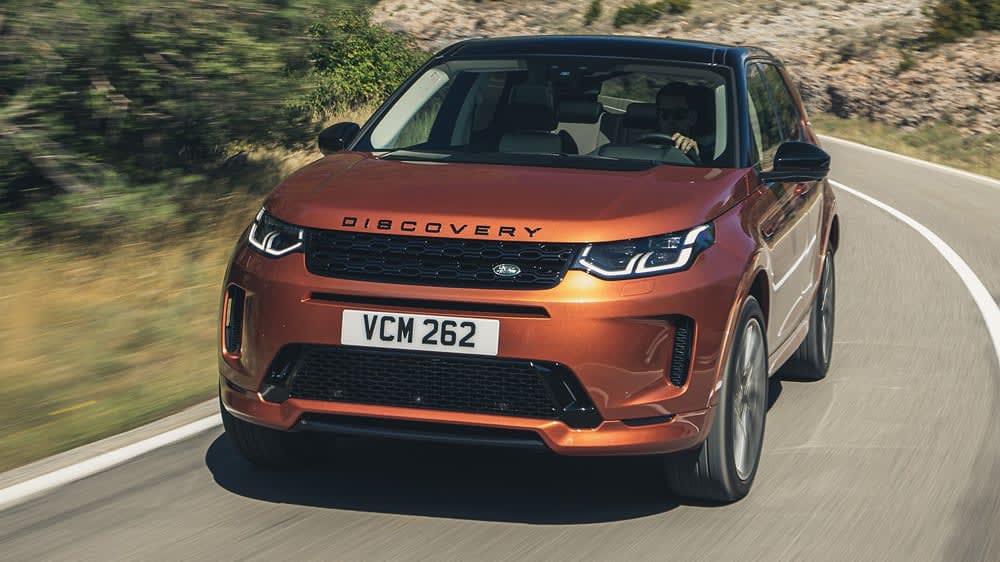
Better still, it’s a quiet, capable 4x4 that’s as happy to tow a horse box across a farmyard as it is to cruise down the M1. You can choose between the ‘standard’ off-roader image or go for one of the sportier R-Dynamic models, and you get a wide choice of mild-hybrid petrol and diesel engines, as well as a powerful, eco-friendly plug-in hybrid.
Key Features
The problem with large SUVs is that they tend to be, well. Large. But the Discovery Sport offers 95% of the practicality you get from a big, seven-seat 4x4 without being too big to manoeuvre along a country lane. It offers luxury and refinement, too, providing an immensely quiet, refined drive on any kind of road. And Land Rover is catching the pack when it comes to technology, with some neat touches such as the ClearSight rear-view mirror and the digital climate control panel. And all that is combined with Land Rover’s legendary off-road capability, which allows the Discovery Sport to conquer terrain that’s more challenging than most drivers would ever try to tackle.
Performance & Drive
The Discovery Sport comes with a choice of 2.0-litre petrol and diesel engines, with power outputs ranging from 165hp to 290hp. Then there’s a plug-in hybrid version, which squeezes 309hp from a 1.5-litre petrol engine and an electric motor. The 2.0-litre engines are the cheaper options, and even the diesels are remarkably quiet. Beware, though, because the less powerful engines do feel a bit gutless in a car that weighs almost two tonnes. They aren’t worryingly slow, but you do miss the punch of a more potent motor.
Diesel power probably suits the car best, giving the car plenty of grunt at low engine revs, and they’re so quiet you barely realise the engine is present. Of course, that comes with its downsides. You can hear the road and wind noise slightly more than you might expect, and although that isn’t enough to stop the Discovery Sport being a quiet motorway cruiser, you just get the feeling it isn’t as quiet as it could be.
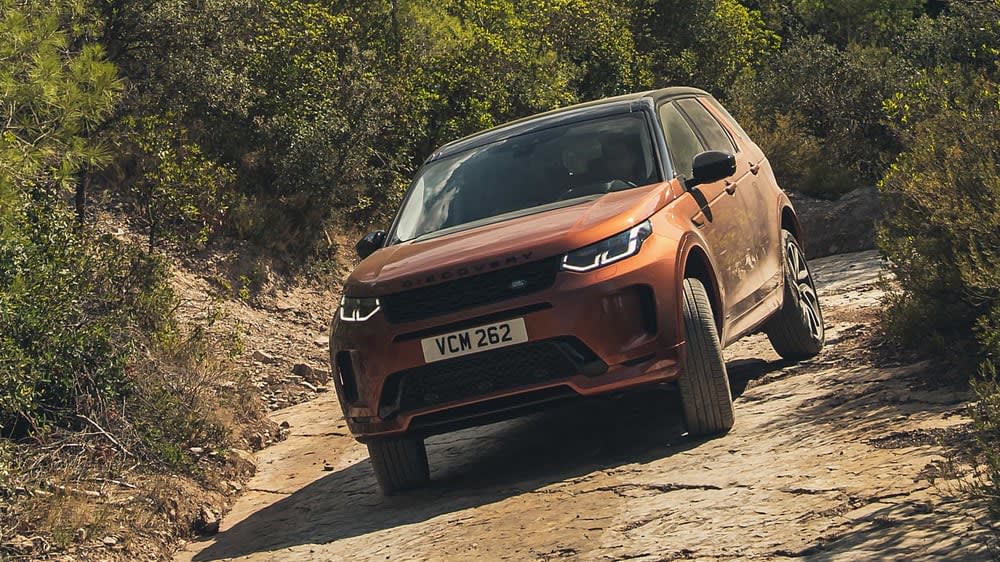
But while there are holes to be picked in the soundproofing, the suspension is almost faultless. Despite the ‘Sport’ name, the car’s tuned overwhelmingly in favour of comfort, and it delivers beautifully. On any road, this car feels remarkably supple and sure-footed, yet it’s still sturdy. That’s partly thanks to the steering, which feels smooth and consistent, but it’s mainly because Land Rover hasn’t tried to make this car drive like a hot hatchback. It’s a big family car, and it doesn’t try to be anything else.
That said, it is also an enormously capable 4x4. Rivers, hills and muddy farm tracks are no sweat for the Discovery Sport, which shrugs such obstacles aside with disdain. Even serious off-roaders won’t find much this car won’t manage, so you know there’s no problem leaving it in the local football club’s mudbath-cum-car park.
Running Costs
One of the big criticisms of the old, first-generation Discovery Sport was its inefficiency, and Land Rover has tried to counter that with the addition of mild-hybrid technology across the range. On paper, at least, it seems to have worked, with marginal improvements in economy compared with the old car. On the road, though, the petrol engines can be quite thirsty – particularly if you’re wearing your lead boots.
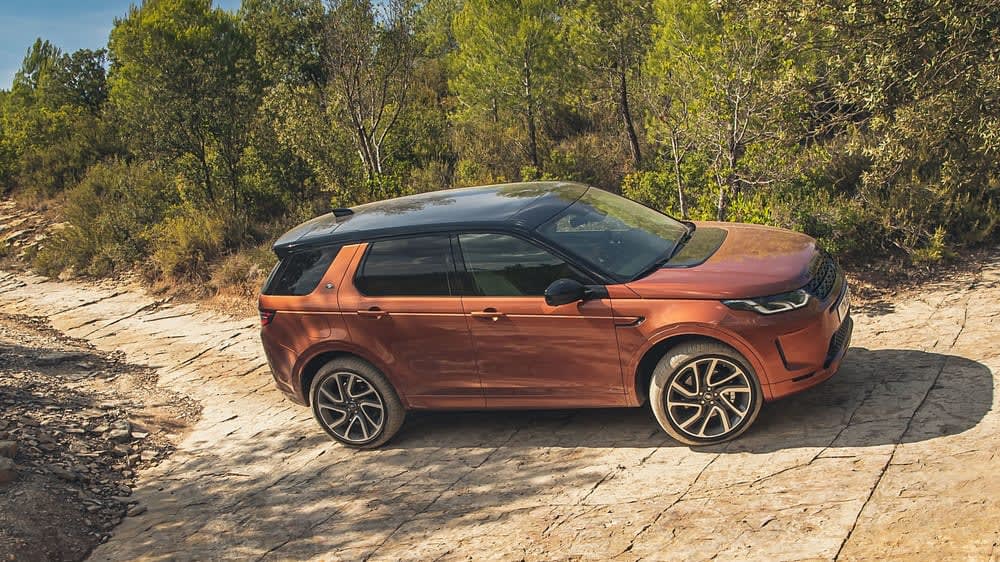
Diesel, then, will make the most sense for many drivers, but the plug-in hybrid shouldn’t be ignored. Yes, you need a very specific lifestyle to make the most of the petrol-electric powertrain, but it’ll do up to 38 miles on a charge and if your commute is only 10 miles, that’ll probably be enough. Charge every night and you won’t use a drop of petrol all week.
Even with mild-hybrid power, the petrol Discovery Sports leave a little to be desired on the emissions front. The diesels fare slightly better, but they still aren’t as eco-friendly as some, leaving them stranded in slightly higher company car tax brackets. Only the plug-in hybrid is likely to appeal greatly to company car buyers, who will be drawn in by the 39g/km CO2 emissions.
Interior
When the updated Discovery Sport was first launched, the cabin was arguably its biggest weak point. Now, though, it’s improved enormously, getting more premium materials and a more modern design. The centre console and dashboard have improved enormously, with soft, tactile plastics and a more modern infotainment system. That theme continues throughout, with design features that have trickled down from the even more luxurious Range Rover models and the larger Discovery. The steering wheel comes with some classy switchgear, and there’s a clever digital display for the climate control system. The gear lever is straight from a Range Rover, too.
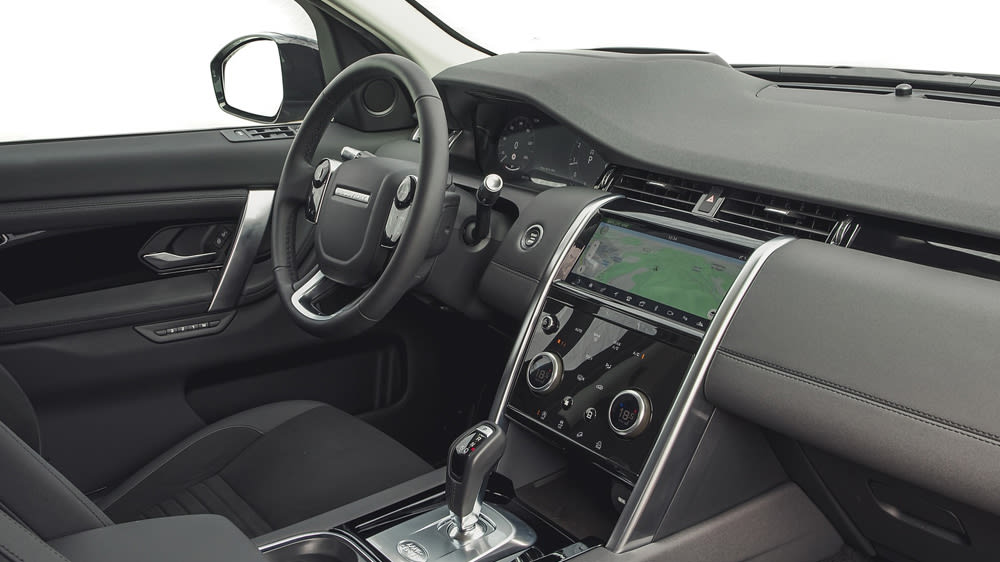
The colour schemes also add to the impression of luxury, with the traditional black complemented by some lighter, brighter tones that add a real airiness to proceedings. You get a choice of classic wood veneers, too, plus some more contemporary metallic finishes. Just as important, however, is the substance to back up the style, and everything feels solid to the touch. Sure, there are a few exceptions to the rule, such as the knobs for the temperature settings, but these issues only pop up occasionally. By and large, it’s a lovely place to be.
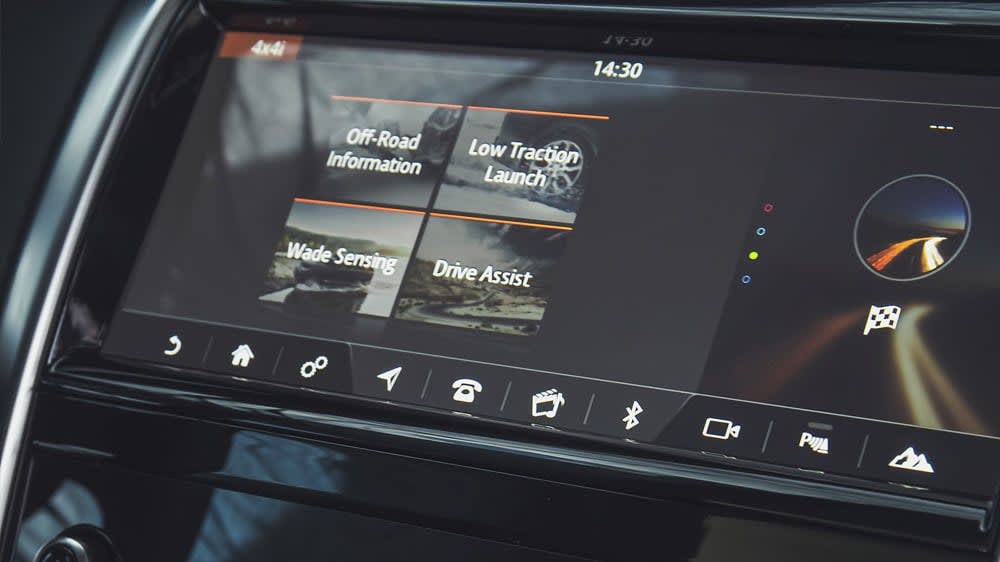 very model in the Discovery Sport range comes with Land Rover’s Pivi infotainment system, which is a step ahead of what’s gone before. Land Rover’s reputation in this department isn’t brilliant, but it’s starting to close the gap on the likes of BMW and Audi. That means you now get a modern-looking display, crisp graphics and all the gadgets you expect from a luxury car. More luxurious models get a digital instrument cluster, along with a head-up display and a Meridian sound system. And with plenty of USB ports on offer, you’ll be able to plug in your tech with ease.
very model in the Discovery Sport range comes with Land Rover’s Pivi infotainment system, which is a step ahead of what’s gone before. Land Rover’s reputation in this department isn’t brilliant, but it’s starting to close the gap on the likes of BMW and Audi. That means you now get a modern-looking display, crisp graphics and all the gadgets you expect from a luxury car. More luxurious models get a digital instrument cluster, along with a head-up display and a Meridian sound system. And with plenty of USB ports on offer, you’ll be able to plug in your tech with ease.
Practicality & Boot Space
The Discovery Sport is one of Land Rover’s smallest cars, but it still feels big on the inside. As you might expect, headroom is plentiful in the front and rear, while the two front seats feel nicely spaced. You get bags of legroom in the back, too, although the occasional rear seats are far too tight for adults to sit comfortably. If you want to carry your kids’ schoolmates from time to time, however, they’ll probably do the job.
And because this is supposed to be the more practical version of the Range Rover Evoque, you won’t be surprised to find an enormous boot. Five-seat examples manage 963 litres of space back there, and ‘5+2’ seven-seaters still manage 840 litres if the third-row seats are tucked away. Even with the third row of seats in place, 225 litres isn’t bad going. You don’t get that much space in the back of a Toyota Aygo.
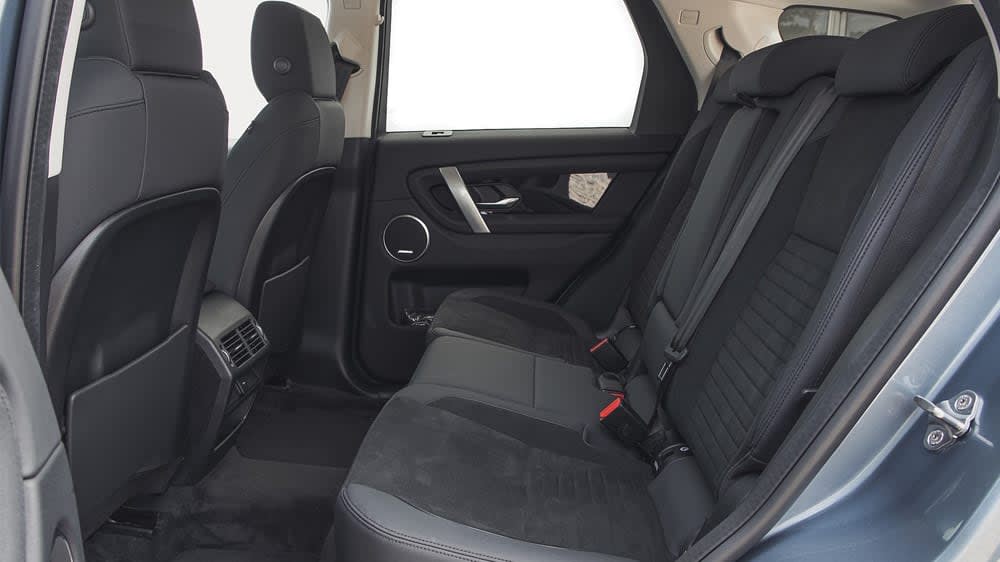
Getting stuff in there is easy, too. Yes, the car sits high so loading heavy items takes a little more brute force and ignorance, but you can level that accusation at any luxury SUV. The Discovery Sport makes up for that with the Activity Key, which allows access to the car even if it’s tipping it down and you can’t find the keys. High-end models also come with a hands-free tailgate system, allowing you to kick the air under the bumper to open the boot.
Safety
The Discovery Sport comes with a five-star Euro NCAP crash test rating, which should provide some peace of mind. Although the test was carried out on the first-generation car way back in 2014, it still scored 93 percent for adult occupant protection, and the updated model should be even safer.
All but the basic S models get blind-spot monitoring to stop you colliding with cars hidden over your shoulder, while safety kit such as automatic emergency braking, which hits the brakes autonomously if you’re about to have a crash, is standard. You get three Isofix mountings, too, allowing you to put child seats in the rear bench and the front passenger seat.
Options
Land Rover appears to have made the Discovery Sport range wantonly complicated, but fear not, because it’s simpler than it looks. In essence, you get a choice of two main models, each of which comes with three different ‘specification packs’. First, then, you have to choose between conventional Discovery Sport or the sportier R-Dynamic model. There’s little to choose in terms of specification, but the R-Dynamic gets black exterior touches, body-coloured wheel arches and sportier bumpers.
Whichever route you choose, you’re then presented with three different versions, each with increasing levels of equipment. On the conventional car, the entry-level S comes with 18-inch alloy wheels and heated leather seats, not to mention a 10-inch touchscreen and a 360-degree parking camera that offers a bird’s-eye view of the car and its surroundings. Moving up to the SE gets you bigger wheels, a powered tailgate and a digital instrument cluster, while the HSE gets a Meridian sound system, keyless entry and some extra driver assistance technology.
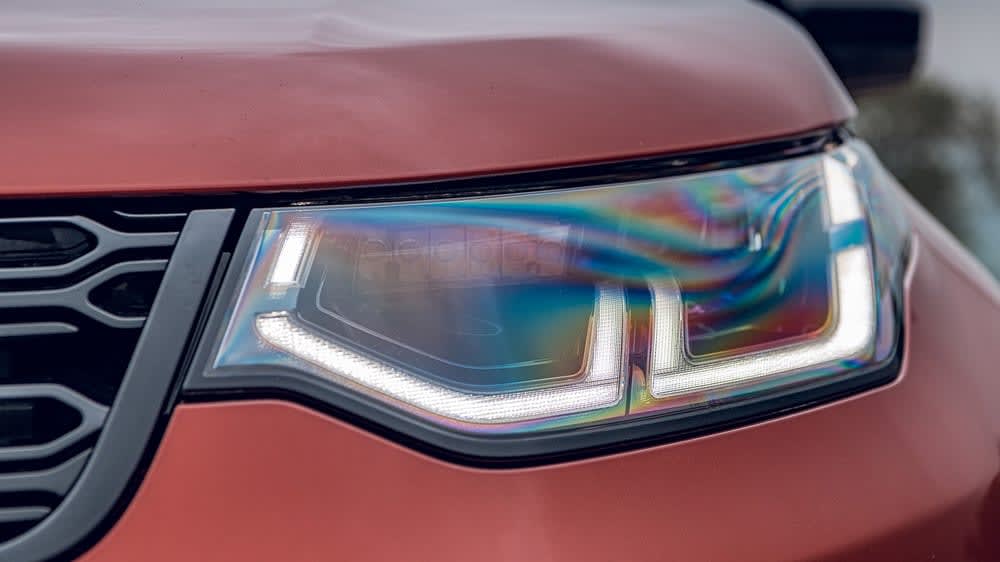
If you choose R-Dynamic, however, the S is eschewed in favour of the S Plus, which gets the larger alloy wheels and powered tailgate of the SE model. Otherwise, the range is broadly similar to the standard Discovery Sport line-up. However, customers can also choose a Black edition, which is based on the R-Dynamic but comes with a black roof with a panoramic glass panel and red brake callipers.
A range of optional extras are available, from glorious colours like Firenze Red and Portofino Blue to option packs such as the Warm Climate Pack, which adds a handful of extra comfort features. What’s available depends on which specification pack you have chosen, but there is plenty to go at. The ClearSight rear-view mirror, which allows you to flip between a rear camera display and a conventional mirror, might be worth a look if you regularly carry lots of luggage, while the waterproof Fitbit-style Activity Key might suit more active drivers.
Who Rivals The Discovery Sport?
The luxury SUV market is booming like few others, and the Discovery Sport is not short of competition. Not only does it have the great-to-drive BMW X3, Jaguar F-Pace and Porsche Macan for company, but the stylish Audi Q5 and Mercedes-Benz GLC are breathing down its neck, too. And then there are the left-field choices, such as the quirky DS 7 Crossback and the hybrid-powered Lexus NX.
Arguably the most worthy rival, however, comes from within the Land Rover stable. It’s called the Range Rover Evoque, and under the skin, it’s the same car as the Discovery Sport – albeit with a slightly less practical body. It’s a looker, though, and unless you desperately need seven seats or a huge boot, plenty will be swayed by the combination of image and ability.
Verdict & Next Steps
The Discovery Sport is the Evoque’s more mature, grown-up sister, offering all the space you really need without the hassle of driving an enormous 4x4. Yet it’s no less premium for that, with supreme comfort and refinement leaving you in no doubt that you’re driving a luxury car. Combine that with the assurance provided by such ample off-road capability and the low emissions of the plug-in hybrid, and you’ve got a car that will take family life in its stride. It’s all the luxury 4x4 you’ll ever need.
Lease price: from £341.95*
Looking for another luxury SUV favourite? Read our new Range Rover Evoque MHEV Review or Tesla Model X Review
*Score based on Select’s unique meta score analysis, taking into account the UK’s top six leading independent car website reviews of the Focus.
**Correct as of 17/09/2020. Based on 9 months initial payment, 5,000 miles over a 48 month lease. Initial payment equivalent to 9 monthly payments or £3,077.57 Ts and Cs apply. Credit is subject to status.



















